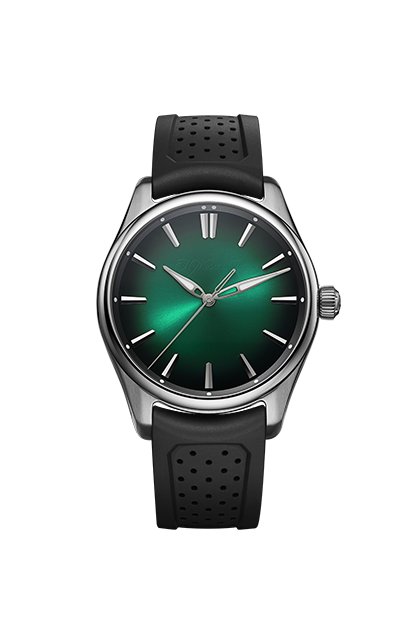The world of horology is a vast landscape of artistry and precision engineering, and there’s an unmistakable allure to the dance of gears and springs that power a timepiece. At the heart of many luxury watches sits an automatic movement, the intricate internal mechanism that powers its functions. H. Moser & Cie. has been a cornerstone in the world of Swiss watches for almost two centuries, and our story, rich with both tradition and innovation, has a special chapter dedicated to automatic movements. But what exactly is an automatic movement, what makes it different to a quartz or mechanical movement, and how has H. Moser & Cie. contributed to its evolution?
What is an automatic movement?
The attraction of automatic movements lies in their self-sufficiency. Imagine a watch that harnesses the energy of your daily movements, winding itself without any manual intervention. That’s the magic of an automatic movement. It’s a mechanism that uses the motion of the wearer’s arm to wind the mainspring, providing energy to turn the hands and run the watch. It’s a harmonious blend of convenience and craftsmanship, ensuring your watch ticks every second, for as long as you do.
At the heart of an automatic movement is the rotor, a semi-circular piece of metal that moves with the motion of the wearer’s arm. The rotor is connected to the mainspring through a series of gears. As the rotor moves, it winds the mainspring, storing energy. When the mainspring unwinds, this energy reserve is transferred through a series of gears and springs which regulate the release of energy to power the watch hands and keep accurate time.
You can’t stop progress
The convenience and precision of automatic movements quickly made them an industry favourite, transforming the way people thought about timepieces. Technical advancements in the world of horology have meant these movements have evolved significantly, and as an integrated manufacturer – meaning we design and build our movements in-house – H. Moser & Cie. have been at the forefront of that evolution. Over the decades we’ve introduced a multiverse of timepieces, but our journey with automatic movements is particularly remarkable.
Partners in style
H. Moser & Cie.’s reinterpretation of the classic sports chronograph, the Streamliner Flyback Chronograph, is as visually striking as it is technically advanced. Created in collaboration with the brand’s partners, Agenhor, its automatic chronograph movement ensures precision, while its unique combination of retro design and modern mechanics make it a conversation starter in any environment.
Another noteworthy model with an automatic movement, from our athletic Pioneer collection, is the Pioneer Centre Seconds. A watch for the contemporary explorer, it combines unparalleled resilience with the height of sophisticated aesthetics. The automatic movement is encased in stainless steel, and the signature fumé dial – whether Arctic Blue, Purple Haze, or any of the other vibrant offerings – adds more than a touch of luxury. Its robust yet elegant design makes it a perfect companion for those who seek adventure and precision, and reflects the brand’s belief that a watch should be as dynamic as the life of its wearer.
Automatic and manual: what’s the difference?
While automatic and manual movements share the same basic principles, there are some differences. Let’s explore some of them.
Aspects | Automatic movements | Manual movements |
|---|---|---|
|
Winding method |
Self-winding; uses the wearer’s wrist movements to wind the spring. |
Manually wound by turning the crown on the side of the watch. |
|
Power source |
Powered by a mainspring, automatically wound by a rotor. |
Powered by a mainspring, which is wound by hand. |
|
Winding frequency |
Winds itself as long as it is worn regularly. |
Requires regular winding. |
|
Design complexity |
Potentially more complex due to the addition of a self-winding mechanism. |
Potentially less complex than automatic movements. |
|
User interaction |
Minimal interaction needed for winding. |
Requires active interaction for winding. |
|
Typical uses |
Convenient for daily wear due to automatic winding. |
Often preferred by enthusiasts for the tradition and skill involved. |
More than an accessory
When you wear an automatic watch, especially one from H. Moser & Cie., you’re not just wearing a functional accessory. You’re adorning a piece of history, a reflection of decades of innovation, and a celebration of fine watchmaking.









